|
One reason why I haven’t gone earlier than 1940 in this
chronological list is that satire depends on a certain amount of
currency in order to be effective, and the further off we are in
time from a given movie, the less likely it is to affect us
directly. This isn’t invariably true, and it certainly doesn’t apply
to literature: think of Voltaire’s
Candide, first published in
1759, which probably seems more “up to date” today than Terry
Southern and Mason Hoffenberg’s
Candy, first published in 1958.
But it’s also important to realize that one of the best ways to
understand a historical period is to discover how it was ridiculed
by its contemporaries.
With some significant exceptions—-Stanley Kubrick’s
Dr. Strangelove is one of the
most striking—-satire, as playwright and Algonquin wit George S.
Kaufman once put it, is what closes in New Haven, and this is
especially true of most movie satires. Apart from the studio fodder
(the first two items here), and discounting the arthouse features of
Buñuel and Kiarostami, all these movies were either flops or at most
modest successes, and some were resounding flops. No matter how
hilarious it looks today,
Will Success Spoil Rock Hunter?
(see below) was such a resounding commercial flop when it came out
in 1957 that it nearly destroyed Frank Tashlin’s career. But
The Girl Can’t Help It, another
Tashlin satire with Jayne Mansfield that preceded it at the same
studio, did pretty well (no doubt in part because of its generous
offerings of rock-n-roll), and a similar contrast can be found in
comparing such uncommercial (albeit great) Charlie Chaplin satires
as
Monsieur Verdoux and
A King in New York with his
earlier
The Great Dictator (the biggest
hit of his career). Maybe this has something to do with how willing
audiences are at certain periods to hoot at themselves, but even
here no hard and fast rules seem to apply. It’s a matter of
historical record that Adolf Hitler, the major target of
The Great Dictator, was
sufficiently amused by the film to see it twice.

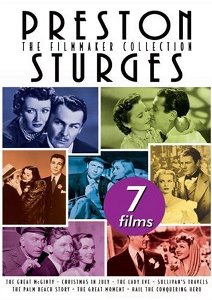 |
1)
Christmas in July
(1940). For all the rising popularity of Preston Sturges
as a master writer-director of screwy, satirical,
all-American farces, his second feature continues to be
one of his most neglected, even though its story about
winning a contest to furnish a band of coffee with the
best advertising slogan is among his most memorable. In
fact, the office clerk (Dick Powell) at the company who
believes he’s won the contest with his own jokey slogan
(”If you can’t sleep at night, it isn’t the coffee,
it’s the bunk”—-a sentence the movie employs like a
crazed, tribal mantra) is actually the victim of a
practical joke, a hoax concocted by his fellow workers.
But after he runs off and spends a fortune purchasing
gifts for himself, his fiancée (Ellen Drew), and his
neighbors, believing that he’s struck the jackpot, his
coworkers grow increasingly reluctant to inform him
about their prank. Despite the apparently contemporary
setting, this manic comedy has a great deal to do with
the desperate fantasies of opulence developed during the
Depression, with especially fragrant moments of
eloquence and bluster from a few of Sturges’ favorite
bit actors--Raymond Walburn, William Demarest, and
Franklin Pangborn. |
|
 |
|
2)
Tarzan’s New York Adventure
(1942). To cite a fairly primitive but none the less
enjoyably unpretentious example of satire, check out
this mainly routine romp directed by Richard Thorpe in
which Boy (Johnny Sheffield) gets kidnapped from the
African jungle by circus animal hunters (including
Charles Bickford and Chill Wills), and Tarzan (Johnny
Weissmuller) and Jane (Maureen O’Sullivan) have to fly
to New York in order to rescue him. “We’re going into
places that are more tangled than the worst underbrush
in the jungle,” Jane cautions Tarzan before they depart
for the urban jungle, suggesting that Myles Connolly and
his screenwriting cohorts were perfectly aware of some
of the ironies involved—-although I suspect that Tarzan
getting routinely fingerprinted at U.S. Customs wasn’t
intended as a gag.
If you aren’t too distracted by Tarzan speaking pidgin English (“Jane
beautiful—-Jane good”) while Jane and Boy talk like
ordinary suburbanites, you might be amused by the way
New York--and, more generally, modern technology and
appliances--gets interpreted by Tarzan. |
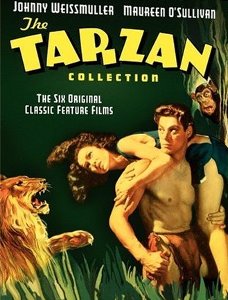 |
(For a far more sophisticated version of the same kind of humor, check out Jean Rouch’s 1969
Petit à petit, unfortunately
available only without subtitles, in which the black hero from Ghana
comes to Paris and winds up measuring the skulls and pondering
ethnographically the quaint folkways of white Parisians.) Otherwise,
this is mainly notable for superb stunts by Cheetah the chimpanzee
and various elephants—-the true stars of this movie, and in some
respects the most intelligent characters.
|
 |
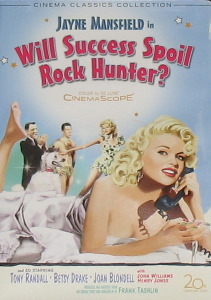 |
3)
Will Success Spoil Rock Hunter?
(1957) Along with Chaplin’s
A King in New York,
made the same year, this Frank Tashlin comedy about
Madison Avenue, the media, and Jayne Mansfield, starring
Tony Randall in his most brilliant performance, is the
most devastating satire about 50s America to be found
anywhere. But whereas the Chaplin comedy was made by
necessity in exile (since Chaplin had been officially
barred from re-entering the U.S. at this point, and had
to simulate his New York in London) as well as
independently (like all of Chaplin’s other features),
Tashlin’s far more avant-garde masterpiece was actually
produced at 20th Century-Fox, apparently when no one was
looking. A scathing look at the success ethic, bursting
with audacious formal conceits--starting with the
opening precredits sequence, when Randall is seen
single-handedly performing Fox’s opening logo theme on
various instruments --this is characterized throughout
by Tashlin’s affection for all his characters, a trait
he basically shares with Chaplin. (There’s no such thing
as a real villain to be found in any Tashlin film,
despite the ferociousness of the cultural critique.)
|
|
 |
4)
Lord Love a Duck
(1966). George Axelrod, who wrote the stage comedy that
Will Success Spoil Rock Hunter?
was at least putatively based on, made the first of his
two memorable features with this caustic, black and
white satire about southern California youth culture in
the mid-60s—-a comedy so dark and morbid in its view of
sexual hysteria and the American dream that it probably
comes closer to approximating the work of novelist
Nathanael West than any other movie. (It certainly comes
a lot closer than the would-be movie versions of West’s
two best and best-known novels--the horrendously
compromised 1958
Lonelyhearts and
the diluted and sentimentalized 1975
The Day of the Locust—-not
to mention the contemporaneous and somewhat better black
and white movie about southern California adapted from
Evelyn Waugh’s
The Loved One,
released in 1965.)
I don’t know anything about the Al Hine novel that
Axelrod and Larry H. Johnson adapted for this movie, but there’s no question that Axelrod and
his star Tuesday Weld bring their own unmistakable
stamps to this special material. One delirious scene in
which Weld’s character goes shopping with her father for
sweaters is so audacious about sexual and incestuous
delirium that one can hardly believe one’s ears and
eyes. Among the other fine actors here are Lola Albright
(the heroine’s mom) and Roddy McDowell (her
Mephistophocles). |
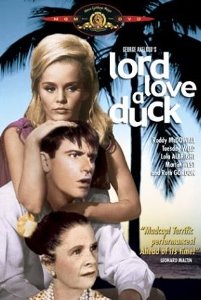 |
|
 |
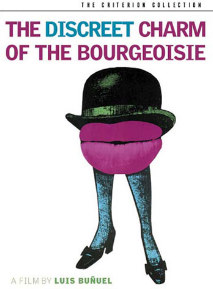 |
5)
The Discreet Charm of the
Bourgeoisie (1972). Three weeks before
Luis Buñuel won his first and only Oscar for this
avant-garde comedy, he was asked by Mexican reporters,
shortly after the film’s nomination, if he thought he
might win. “Of course,” was his deadpan reply. “I’ve
already paid the $25,000 they asked for. Americans may
have their weaknesses, but they do keep their promises.”
In point of fact, some critics concluded that the Oscar
proved that Buñuel was something of an artistic and
political sellout, even if he won the prize fair and
square. But I wonder how many of them would argue the
same thing today, because it’s hard to think of any
other Oscar winner that’s quite as subversive, either as
narrative or as social commentary.
Admittedly the three upper-crust couples he focuses on, all of whom
spend the entire movie trying unsuccessfully to have a meal
together—-Fernando Rey and Delphine Seyrig, Stéphane Audran and
Jean-Pierre Cassel, Bulle Ogier and Paul Frankeur—-are shown as
imperturbable, despite all the countless interruptions
and various contemporary horrors invading their lives. |
But Buñuel’s somewhat
resigned view of these charming monsters is far from being a simple
endorsement. Insofar as he’s equating these characters with the
seductive charms of commercial narrative cinema, this becomes a
pretext for lighting the fuses of various bombs under their—-and
our--seats.
|
 |
|
6)
The Long Goodbye
(1973). The late Robert Altman’s funniest as well as
most nightmarish feature is in part an eerie send-up of
Raymond Chandler’s Philip Marlowe ethic in relation to
what was then present-day Los Angeles. It moves
periodically beyond satire in various ways—-in its
continuously moving camera, which sets both viewers and
characters adrift, in its shocking and/or tragic
dislocations (such as a Jewish gangster played by
director Mark Rydell smashing his girlfriend in the face
with a Coke bottle for no good reason, or an alcoholic
novelist played by Sterling Hayden steadily unraveling
before our eyes), and in Marlowe himself, a mainly
dysfunctional gumshoe who loses his cat, movingly
portrayed by Elliott Gould. Still, it’s largely the
goofy satire here that keeps this going, extending to
such facets as Marlowe’s stoned-out neighbors and the
endless variations that we hear in the movie’s title
tune. |
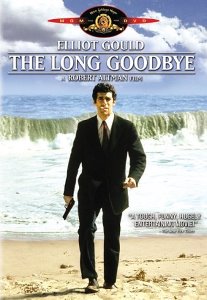 |
|
 |
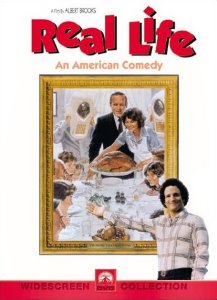 |
7)
Real Life (1979).
Producer-director-cowriter-star Albert Brook’s first
feature--a withering send-up of the 1973 PBS series An
American Family (which might be described as the
original Reality TV)—-is still in many ways the
funniest, as well as his all-around best (with the
possible exception of his second feature,
Modern
Romance-- the second time he plays a filmmaker). But
don’t think you have to have seen
An American Family to
appreciate any part of this. (I never even sampled the
series myself, since I was living abroad at the time.)
Brooks does more hilarious stuff with show-biz vanity
than anyone else in the business, and the fact that he’s
playing himself—-as he subsequently does in his most
recent feature,
Looking For Comedy in the Modern
World—-only adds to the impertinence. This time around,
he’s making a (fictional) documentary about a supposedly
typical family, that of a veterinarian (Charles Grodin)
in Phoenix, Arizona. |

|
8)
The King of Comedy
(1983). I didn’t warm to Martin Scorsese’s own poisoned
valentine to the world of show biz the first time I saw
it, but it’s grown steadily in stature ever since.
Working with a brilliant script by the late film
reviewer and film journalist Paul D. Zimmerman, it
focuses on a pathetic wannabee TV comic named Rupert
Pupkin (Robert De Niro) who buttonholes a Johnny
Carson-type host (Jerry Lewis) and eventually, with the
help of another deranged fan (Sandra Bernhard in her
sizzling screen debut), kidnaps him as a ruse for
breaking into show business. In many ways the evil twin
of Scorsese and De Niro’s earlier poem about the
humiliation of New York failure,
Taxi Driver,
The King of Comedy
actually moves beyond it in unsentimental candor--especially
when it comes to Jerry Lewis’s frightening, deliberately
unfunny performance, and, more generally, the movie
connecting an all-American hatred for one’s family with
a love for celebrities. (Listen closely to Pupkin’s
climactic comic monologue.)
|
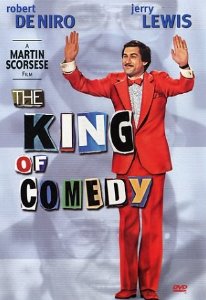 |

 |
9)
Ishtar (1987). The
most despised movie on this list is actually a very
prescient (meaning extremely up-to-date) satire about
the bumbling idiocy of the U.S. in the Middle East,
brokered by the C.I.A. (Charles Grodin again, even
funnier than he is in Real Life), fed by escalating
cluelessness, and helped along by a Reagan-era mentality
in which a peace settlement can be arrived at only with
the help of a show-biz agent (Jack Weston, hilarious).
It’s also a surprisingly sweet-tempered farce about
lovable lunkheads (Warren Beatty and Dustin Hoffman),
both untalented New York songwriters and singers, who
eventually find themselves, along with Isabelle Adjani,
in the midst of a war in the Middle East.
In fact, the bad reputation of this movie has relatively
little to do with the brilliance of its writer-director,
Elaine May, in her last feature to date—-apart from the
vindictive behavior of the studio about the movie going
way over budget because of her perfectionism--and quite
a lot to do with the high-handedness of its
producer-star, Warren Beatty, in dealing with
journalists, who found in this movie a perfect means of
exacting their revenge. |
|
(Anyone who witnessed Beatty publicly humiliating Roger
Ebert and Gene Siskel in the midst of a tribute to him
at the Toronto film festival, for instance, is apt to be
unsurprised at the vituperation of both critics towards
Ishtar.) But now that all these old grudges have become
irrelevant, what remains is a pretty wonderful comedy.
If you don’t believe me, check it out for yourself.. |

|
10)
The Wind Will Carry Us
(1999). My favorite feature by Abbas Kiarostami—-the
most beautiful and profound, and in many ways the
funniest--is a not-so-veiled autocritique about how
Kiarostami himself deals with poor peasants, played out
mainly as comedy. The fact that Kiarostami is an
innovative Iranian filmmaker who works without scripts
in the usual sense is interesting, but ultimately less
important than the universality and topicality of his
theme, which satirizes the short-sightedness of big-city
media types around the world-—the hero’s mobile phone is
a major prop--who feel lost as well as stranded when
they’re in the sticks, living in a separate time frame
from the locals while waiting restlessly for something
to happen. To get a better sense of how Kiarostami is
satirizing himself and his own methodology, check out
Yuji Mohara’s 90-minute A Week with Kiarostami,
available in the English-subtitled French edition of
this feature, which reveals startling as well as
fascinating details about how this film was made. |
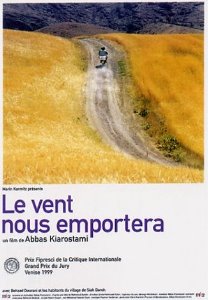 |

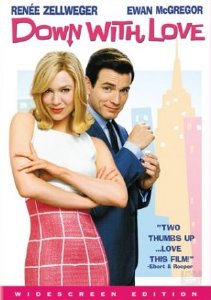 |
11)
Down with Love
(2003). Peyton Reed’s hyperbolic and inventive parody
attempts to satirize three comedies with Doris Day and
Rock Hudson that I couldn’t care less about--Pillow
Talk (1959),
Lover Come Back
(1961), and
Send Me No Flowers
(1964). To tell the truth, I’m actually glad that the
filmmakers, too young to have experienced this period
directly, get most of it wrong--from the credits to the
gigantic Manhattan penthouses (cf.
How to Marry a Millionaire
and
The Tender Trap) to
the “think-pink” advertising décor (cf.
Funny Face and
Will Success Spoil Rock Hunter?),
all of which date from 1953-1957—-because the fact that
they believe in all this matters much more than what
they believe. Furthermore, the visual and verbal double
entendres, antismoking gags, and overt references to
feminism and homosexuality all clearly come from after
1964. |
|
No cause for alarm. The filmmakers’ giddy collapse of
the 50s, 60s, 70s, and 80s into a hyperbolic dream of a
dream speaks volumes about who we are today, expressing
a yearning for what’s wrongly perceived as a less
cynical and more innocently romantic era. Preoccupied
with a trio of hypocritical comedies as if they
contained awesome, precious secrets,
Down with Love
offers many creative and poetic insights into some of
the more tender aspirations of today. |

|
12)
Find Me Guilty
(2006). This courtroom comedy—-perhaps the most
entertaining feature that octogenarian Sidney Lumet has
ever made, based on a true story about what was
reportedly the longest trial in U.S. history—-came and
went so fast that you might never have heard of it. It’s
about the trial of New Jersey mobster Giacomo DiNorscio,
who acted as his own attorney, and is played with rare
charismatic brio and a great deal of grandstanding by
Vin Diesel. What makes it for me so timely and relevant
a satire is what it demonstrates about our
unacknowledged complicity with criminals—-how much we
enjoy them and how much we forgive them for their
crimes, at least if they put on a good show for us,
regardless of what we claim. Lumet, who coscripted this
subversive tale himself, forces the issue by making this
thug so likable and the forces of law and order so
corrupt that we constantly have to reflect upon what
we’re actually buying into. There’s also a dynamite
sequence when DiNorscio is visited by his estranged wife
(a terrific cameo by Annabella Sciorra) that’s
guaranteed to knock your socks off. |
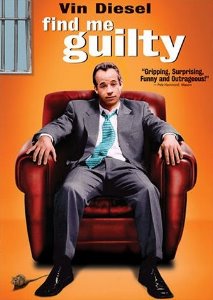 |
|












